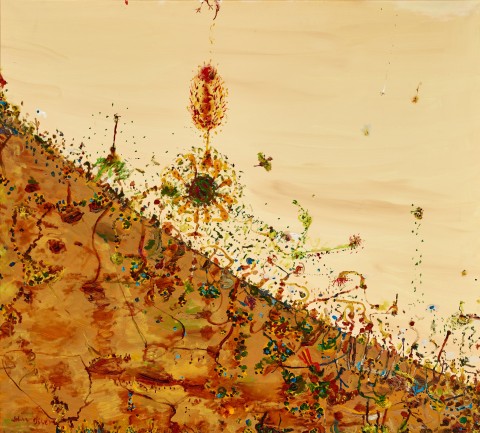VIEW FROM THE STUDIO, c.1986 – 87
JOHN OLSEN
oil on canvas
137.0 x 153.0 cm
signed lower left: John Olsen
Aptos Cruz Gallery, Adelaide
Private collection, Adelaide, acquired from the above in 1989
In late July 1981, John Olsen wrote in his diary: ‘Noela and I arrive at Clarendon in South Australia. This will mark a new period in my life and work. Our house, an old rectory, is like an eagle’s nest, perched over the village. Looking across, we see the breasty hills, in withdrawing ranks. The one opposite is particularly steep, and has sheep climbing on it, and clusters of crows flying up and down. Cockatoos, white and splendid, soar past, the clouds seem at eye level, and sheep tracks make a fascinating meandering over the hills’ surfaces.’1
A small town about thirty kilometres from Adelaide, Clarendon was Olsen’s home for the next seven years and its picturesque beauty would be a constant inspiration for his art, giving rise to such joyous paintings as Golden Summer, Clarendon, 1983 (Art Gallery of New South Wales) and Clarendon Spring, Make Sure the Sun Wipes its Feet, 1984 (Broken Hill City Gallery). In 1985 Olsen was awarded the Wynne Prize for landscape painting for A Road to Clarendon: Autumn, 1985, this very public accolade confirming the brilliance and wide appeal of these paintings. The accolades have of course continued – from the recent 2005 Archibald Prize win, to the retrospective exhibition shown in Melbourne and Sydney in 2016-17 – throughout a career that has now spanned more than seven decades and which sees Olsen rightly hailed as Australia’s greatest living artist.
The exuberant mark-making and depiction of a riotous cacophony of plant, bird and insect life connects View from the Studio to the Clarendon pictures both visually, and in terms of the feelings of optimism it evokes. The energetic fluency of Olsen’s technique is on full display – from the tracery of swirling calligraphic lines to the lively dots and daubs that describe form as well as movement. His mastery of colour is evident too, subtle on first impression, but emerging more vividly with time.
Wanting ‘to really come to terms with the experience of a total landscape’, Olsen uses his drawn and painted lines to lead the viewer on a journey through the natural environment rather than just presenting a view to be admired from a distance.2 Depicted from above, below and within, his landscapes communicate the wonder of the natural world and the interconnectedness of all living things. While the title of this painting suggests a distant view – as indeed does the dramatic diagonal horizon line – the delicacy and detail of Olsen’s depiction transports us down close to the earth where we can perceive what he describes as ‘a certain mystical throbbing throughout nature.’3
1. Olsen, J., Drawn from Life, Duffy and Snellgrove, Sydney, 1997, p. 151
2. See Hart, D., John Olsen, Craftsman House, North Ryde, 2000, p. 38
3. Olsen, 1956, quoted in https://www.artgallery.nsw.gov.au/collection/works/68.1972
KIRSTY GRANT
